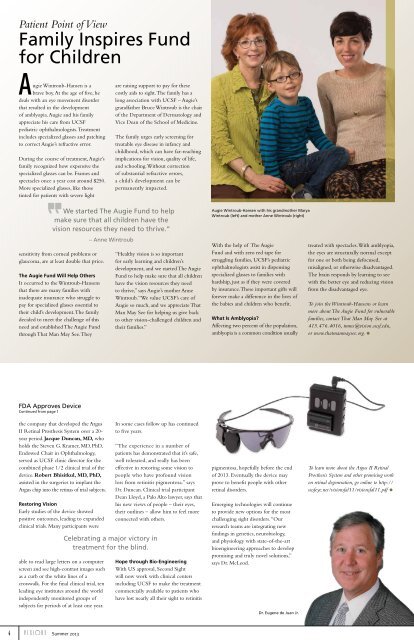Visions Newsletter (pdf) - The Francis I. Proctor Foundation for ...
Visions Newsletter (pdf) - The Francis I. Proctor Foundation for ...
Visions Newsletter (pdf) - The Francis I. Proctor Foundation for ...
You also want an ePaper? Increase the reach of your titles
YUMPU automatically turns print PDFs into web optimized ePapers that Google loves.
Patient Point of ViewFamily Inspires Fund<strong>for</strong> ChildrenAugie Wintroub-Hansen is abrave boy. At the age of five, hedeals with an eye movement disorderthat resulted in the developmentof amblyopia. Augie and his familyappreciate his care from UCSFpediatric ophthalmologists. Treatmentincludes specialized glasses and patchingto correct Augie’s refractive error.During the course of treatment, Augie’sfamily recognized how expensive thespecialized glasses can be. Frames andspectacles once a year cost around $250.More specialized glasses, like thosetinted <strong>for</strong> patients with severe lightare raising support to pay <strong>for</strong> thesecostly aids to sight. <strong>The</strong> family has along association with UCSF – Augie’sgrandfather Bruce Wintroub is the chairof the Department of Dermatology andVice Dean of the School of Medicine.<strong>The</strong> family urges early screening <strong>for</strong>treatable eye disease in infancy andchildhood, which can have far-reachingimplications <strong>for</strong> vision, quality of life,and schooling. Without correctionof substantial refractive errors,a child’s development can bepermanently impacted.We started <strong>The</strong> Augie Fund to helpmake sure that all children have thevision resources they need to thrive.”sensitivity from corneal problems orglaucoma, are at least double that price.<strong>The</strong> Augie Fund Will Help OthersIt occurred to the Wintroub-Hansensthat there are many families withinadequate insurance who struggle topay <strong>for</strong> specialized glasses essential totheir child’s development. <strong>The</strong> familydecided to meet the challenge of thisneed and established <strong>The</strong> Augie Fundthrough That Man May See. <strong>The</strong>y– Anne Wintroub“Healthy vision is so important<strong>for</strong> early learning and children’sdevelopment, and we started <strong>The</strong> AugieFund to help make sure that all childrenhave the vision resources they needto thrive,” says Augie’s mother AnneWintroub. “We value UCSF’s care ofAugie so much, and we appreciate ThatMan May See <strong>for</strong> helping us give backto other vision-challenged children andtheir families.”Augie Wintroub-Hansen with his grandmother MaryaWintroub (left) and mother Anne Wintroub (right)With the help of <strong>The</strong> AugieFund and with zero red tape <strong>for</strong>struggling families, UCSF’s pediatricophthalmologists assist in dispensingspecialized glasses to families withhardship, just as if they were coveredby insurance. <strong>The</strong>se important gifts will<strong>for</strong>ever make a difference in the lives ofthe babies and children who benefit.What Is Amblyopia?Affecting two percent of the population,amblyopia is a common condition usuallytreated with spectacles. With amblyopia,the eyes are structurally normal except<strong>for</strong> one or both being defocused,misaligned, or otherwise disadvantaged.<strong>The</strong> brain responds by learning to seewith the better eye and reducing visionfrom the disadvantaged eye.To join the Wintroub-Hansens or learnmore about <strong>The</strong> Augie Fund <strong>for</strong> vulnerablefamilies, contact That Man May See at415.476.4016, tmms@vision.ucsf.edu,or www.thatmanmaysee.org. •FDA Approves DeviceContinued from page 1the company that developed the ArgusII Retinal Prosthesis System over a 20-year period. Jacque Duncan, MD, whoholds the Steven G. Kramer, MD, PhD,Endowed Chair in Ophthalmology,served as UCSF clinic director <strong>for</strong> thecombined phase 1/2 clinical trial of thedevice. Robert Bhisitkul, MD, PhD,assisted in the surgeries to implant theArgus chip into the retinas of trial subjects.Restoring VisionEarly studies of the device showedpositive outcomes, leading to expandedclinical trials. Many participants wereable to read large letters on a computerscreen and see high-contrast images suchas a curb or the white lines of acrosswalk. For the final clinical trial, tenleading eye institutes around the worldindependently monitored groups ofsubjects <strong>for</strong> periods of at least one year.In some cases follow up has continuedto five years.Celebrating a major victory intreatment <strong>for</strong> the blind.“<strong>The</strong> experience in a number ofpatients has demonstrated that it’s safe,well tolerated, and really has beeneffective in restoring some vision topeople who have profound visionloss from retinitis pigmentosa.” saysDr. Duncan. Clinical trial participantDean Lloyd, a Palo Alto lawyer, says thathis new views of people – their eyes,their outlines – allow him to feel moreconnected with others.Hope through Bio-EngineeringWith US approval, Second Sightwill now work with clinical centersincluding UCSF to make the treatmentcommercially available to patients whohave lost nearly all their sight to retinitispigmentosa, hopefully be<strong>for</strong>e the endof 2013. Eventually the device mayprove to benefit people with otherretinal disorders.Emerging technologies will continueto provide new options <strong>for</strong> the mostchallenging sight disorders. “Ourresearch teams are integrating newfindings in genetics, neurobiology,and physiology with state-of-the-artbioengineering approaches to developpromising and truly novel solutions,”says Dr. McLeod.Dr. Eugene de Juan Jr.To learn more about the Argus II RetinalProsthesis System and other promising workon retinal degeneration, go online to http://ucsfeye.net/visionsfal11/visionsfal11.<strong>pdf</strong> •4 Summer 2013


